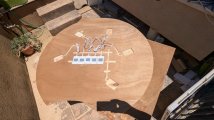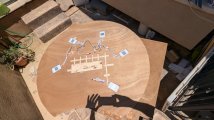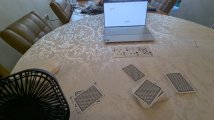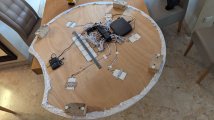You are using an out of date browser. It may not display this or other websites correctly.
You should upgrade or use an alternative browser.
You should upgrade or use an alternative browser.
Experimenting with a DIY RFID Table and Broadcast Overlay (2 Viewers)
- Thread starter eightyWon
- Start date
pokercrit
New Member
I was doing research on this topic and stumble on this thread. I’m a full stack web developer if you need resources in this area. My tech stacks are different than what you are using (.Net, MSSQL, SignalR, React) but willing to learn to contribute.
The project will be open source and available on github once we reach a release version. In that, you'll have all the info you need to have the hardware produced by the PCB manufacturer of your choice and the corresponding software will be available on github as well (along with source code).
There are still enough variables at this point that I'm not comfortable throwing specific cost numbers around so I'll just say that an entire setup should be pretty affordable, especially as compared to existing solutions. I'd further generalize by saying that the cost of building this RFID setup into a table should be a fraction of the cost of your typical table build.
--
Work being done of the rfidReader firmware, focusing lately on the captive portal that'll be used for initial reader configuration (connecting to wifi and pointing the reader's websocket connection to the rfidServer software):
View attachment 1192884
...and a little work being done on the rfidServer portal:
View attachment 1192885
Like I mentioned before, I have about zero UI creativity so we're just customizing a w3css template for now.
Hardware wise, still waiting on the new antennas from OshPark. Might start working on v0.3 of the rfidReader hardware which will focus on a better layout and implementing fixes/lessons learned from the previous two versions.
Hey! I just came across this thread, as I am looking to make a streaming/video setup for some home games I run. Wondering if there is any update on when the open source stuff or production version will be available?
Thank you!
LaBestiole
High Hand
Don’t know about OP, i hope hés doing fine.
On my part, big lack of motivation to continue the project, which usually happens when i consider something is « technically done »… :-/
On my part, big lack of motivation to continue the project, which usually happens when i consider something is « technically done »… :-/
eightyWon
Straight
I know how that goes all too well!Don’t know about OP, i hope hés doing fine.
On my part, big lack of motivation to continue the project, which usually happens when i consider something is « technically done »… :-/
I took a break for a while, too, during the holidays, but I've been back at it for about a month now.
v3 of the reader board is about ready to be sent for production. It addresses various issues, but most importantly it hopefully allows me to more easily tune the antennas. I'm trying to meet the same level of performance I see from the pre-assembled PN5180 modules I've tested with (reliably reading 5-6 stacked cards).
With that, I'm turning my focus back to software again.
We're still months out from beta but there's progress being made.
eightyWon
Straight
v3 in production



eightyWon
Straight
v3 board arrived today, initial testing shows a big improvement in RIFD/antenna performance even without any tuning attempted yet... really encouraging!

I also added some flash memory to this revision to support the firmware requirements as they grow because I think they will as we get further into software development. Haven't tested it much yet, but it does seem to wake up and communicate so w00t
Very happy today!
I also added some flash memory to this revision to support the firmware requirements as they grow because I think they will as we get further into software development. Haven't tested it much yet, but it does seem to wake up and communicate so w00t
Very happy today!
eightyWon
Straight
I am still actively working on this project most days and thinking about and/or researching something related to it daily.Hi eightyWon!
really a great project that you are leading! What are the latest news ?
A while ago I laid out the minimum requirements/functionally I felt I'd need to reach before offering a beta version for testing. Those included things like hardware performance as well as minimum software features/functionally. Since then, that's the stuff I've been focused on accomplishing.
A big part of those minimum requirements is antenna/reader performance. My goals are things like:
- Able to reliably read 4 tightly stacked cards at 5cm with up to a 2m cable
- Able to read at least 6 loosely stacked cards at 5cm with up to a 2m cable
- Able to process all 16 antennas in under 5 seconds
I believe there are still improvements possible through antenna design and tuning which is what I'm working on now. This stuff, however, is something I have no previous experience with and it's a mix of science and black magic. I'm learning stuff every day and do feel like I'm making progress.
it's wild that we're less than a month away from the 2 year anniversary of this thread and it may seem that progress has been slow, but I'm extremely proud of what I've been able to accomplish so far. From the initial proof-of-concept, to designing my own hardware and full stack software development... to me, it's nothing short of amazing. There are whole teams dedicated to bringing projects like this to market, and I'm just some schlub in his basement.
Coulan
New Member
Are you open to collaboration for the web socket and interface? If you are, can you please provide a github link to the repo. I have been looking into something like this.
ekricket
Royal Flush
Can you stagger the placement of the rfid in the cards?With v3 of the board, we're getting very close to some of those goals. For instance, I'm now able to read 3 stacked cards at about 2.5cm, but 4 cards fails unless you spread them a bit. I'm able to read 2 stacked cards at 5cm, but not 2 stacks of 2 cards side-by-side.
CincinattiKiddo
Pair
Goodluck!
Can you stagger the placement of the rfid in the cards?
Wouldn't matter, orientation of the cards relative to each other will still be random.
ekricket
Royal Flush
Ok. It’s more so the rfids aren’t stacked directly on top of each other and can be read clearer. More random would be even better.Wouldn't matter, orientation of the cards relative to each other will still be random.
Ok. It’s more so the rfids aren’t stacked directly on top of each other and can be read clearer. More random would be even better.
Yes, I understand that, but there's almost no way of ensuring RFIDs won't stack on each other randomly after shuffling and dealing with hands of 2-7 cards. It would also be a manufacturing nightmare to try to randomly place small RFID elements on every card back.
ekricket
Royal Flush
I think you greatly underestimate the ability of designers and engineers and automated machinery.Yes, I understand that, but there's almost no way of ensuring RFIDs won't stack on each other randomly after shuffling and dealing with hands of 2-7 cards. It would also be a manufacturing nightmare to try to randomly place small RFID elements on every card back.
You suggested random, I’d advocate for designed placement in 13 different locations. Hell, half that would probably declutter them. But you are the expert not me.
Last edited:
I think you greatly underestimate the ability of designers and engineers and automated machinery.
You suggested random, I’d advocate for designed placement in 13 different locations. Hell, half that would probably declutter them. But you are the expert not me.
Whoa, pull back a bit. The problem is not in the location of the RFID in the cards, it is in the sensitivity and range of the reader.
The end goal of all this tech is to a) accurately read the identity of cards in the hole, and b) eventually accurately read the amount of chips in a bet when moved in stacks. If you can't read a stack of 4 cards, you'll never come close to reading a stack of 2 chips with physical placement of the RFID.
Your local library will allow you to check out a stack of media 4-6" tall without difficulty, so this is solvable on a table felt.
ekricket
Royal Flush
From the OPWhoa, pull back a bit. The problem is not in the location of the RFID in the cards, it is in the sensitivity and range of the reader.
The end goal of all this tech is to a) accurately read the identity of cards in the hole, and b) eventually accurately read the amount of chips in a bet when moved in stacks. If you can't read a stack of 4 cards, you'll never come close to reading a stack of 2 chips with physical placement of the RFID.
Your local library will allow you to check out a stack of media 4-6" tall without difficulty, so this is solvable on a table felt.
The table and associated software will initially support Texas Hold'Em and be able to read the cards of 10 seats plus community cards and the muck (to detect folds/end of hand).
Hopefully you are checking some reading comprehension books out of your local library.RFID-enabled poker table (reads cards, does not read chips)
This project is only for cards. Not chips, and not library books that have rfids placed in a different location in each book. And you may say “they are all in the back cover” or whatever and I might buy that if the were all the exact same size and shape and were all stacked perfectly on top of each other. But they are not.
From the OP
Hopefully you are checking some reading comprehension books out of your local library.
This project is only for cards. Not chips, and not library books that have rfids placed in a different location in each book. And you may say “they are all in the back cover” or whatever and I might buy that if the were all the exact same size and shape and were all stacked perfectly on top of each other. But they are not.
Okay, screw it, I am done with this conversation. I have no idea why you feel it is necessary to use demeaning and offensive language in your reply, when I did nothing to instigate or invite it. What baffles me most is that we have had good conversations in the past, and even done business together, and it saddens me that our difference of opinion on how to approach a technical problem that neither of us is directly involved in should bring out some sort of emotional beast in you. Good luck with staying in your own echo chamber where your screams of "I'M RIGHT!" can only reverberate to your own ears and nobody else's.
ekricket
Royal Flush
Man, I don’t know if I’m right or not. The OP hasn’t weighed in yet at all. You felt the need to chime in and be the expert. Maybe you are, I certainly don’t know. But the OP seems to know his shit and I’d like to hear his opinion, whether it agrees with my thought or not. Can you respect that?Okay, screw it, I am done with this conversation. I have no idea why you feel it is necessary to use demeaning and offensive language in your reply, when I did nothing to instigate or invite it. What baffles me most is that we have had good conversations in the past, and even done business together, and it saddens me that our difference of opinion on how to approach a technical problem that neither of us is directly involved in should bring out some sort of emotional beast in you. Good luck with staying in your own echo chamber where your screams of "I'M RIGHT!" can only reverberate to your own ears and nobody else's.
eightyWon
Straight
gingerLime
Waiting List
Hey all,
Thank you for sharing with us all this info!
I've also started a similar project, but I'm more into the programming compared to my limited electronics knowledge.
I've chosen a simple off-the-shelf $3.5 USB type reader, that could read only one (or maybe two?) cards.
RFID card reader (13.56 mhz model)
I plan to enrich the table with 20-30 of those devices according to the needs, including the community cards place, each player's position, and mucked cards
Those devices are used like external keyboards, so that once a tag becomes near, they type-in an input.
I've used a python script that grabs the keyboard inputs, meaning that the input of the readers goes only to that app.
When multiple "keyboards" or readers were connected, I was able to differentiate between them, and read tags correctly.
But I've jumped pretty much straight to the management page, and to the live display page, and didn't do any tests with a simulation table.
Do you think that setup should work, or I'd have to go learn electronics in order to get this working?
Thank you for sharing with us all this info!
I've also started a similar project, but I'm more into the programming compared to my limited electronics knowledge.
I've chosen a simple off-the-shelf $3.5 USB type reader, that could read only one (or maybe two?) cards.
RFID card reader (13.56 mhz model)
I plan to enrich the table with 20-30 of those devices according to the needs, including the community cards place, each player's position, and mucked cards
Those devices are used like external keyboards, so that once a tag becomes near, they type-in an input.
I've used a python script that grabs the keyboard inputs, meaning that the input of the readers goes only to that app.
When multiple "keyboards" or readers were connected, I was able to differentiate between them, and read tags correctly.
But I've jumped pretty much straight to the management page, and to the live display page, and didn't do any tests with a simulation table.
Do you think that setup should work, or I'd have to go learn electronics in order to get this working?
gingerLime
Waiting List
Hey,
I've got the EM4100 USB port card reader that I've used in initial tests. It did work well with several RFID tags, printing out the input as a 10 digits number.
So I've bought a deck of cards from AliExpress, which looks pretty good btw.
I've started to scan the cards and noticed many of them share the same 10 decimal digits number, so I couldn't distinguish between them.
After some more research, it turns out that those lowcost readers, read only 10 decimal digits out of the full 7 HEX UID of the card, and since many cards share same 4-lo bytes, they virtually have the same ID by that reader.
The cards seller said that they can make a special order with different 4-bytes, but that has a MOQ of 100 units, so around $7000 is way too much.
The reader seller said they can make a full UID read specialized for me, with MOQ of 500 units and 10$ per unit, which has a similar price implications.
I'd think this ACR122U reader should do the job reading the cards, a bit more expensive but workable.
Anyone has an opinion about this direction?
I've got the EM4100 USB port card reader that I've used in initial tests. It did work well with several RFID tags, printing out the input as a 10 digits number.
So I've bought a deck of cards from AliExpress, which looks pretty good btw.
I've started to scan the cards and noticed many of them share the same 10 decimal digits number, so I couldn't distinguish between them.
After some more research, it turns out that those lowcost readers, read only 10 decimal digits out of the full 7 HEX UID of the card, and since many cards share same 4-lo bytes, they virtually have the same ID by that reader.
The cards seller said that they can make a special order with different 4-bytes, but that has a MOQ of 100 units, so around $7000 is way too much.
The reader seller said they can make a full UID read specialized for me, with MOQ of 500 units and 10$ per unit, which has a similar price implications.
I'd think this ACR122U reader should do the job reading the cards, a bit more expensive but workable.
Anyone has an opinion about this direction?
Coulan
New Member
Hey,
I've got the EM4100 USB port card reader that I've used in initial tests. It did work well with several RFID tags, printing out the input as a 10 digits number.
So I've bought a deck of cards from AliExpress, which looks pretty good btw.
I've started to scan the cards and noticed many of them share the same 10 decimal digits number, so I couldn't distinguish between them.
After some more research, it turns out that those lowcost readers, read only 10 decimal digits out of the full 7 HEX UID of the card, and since many cards share same 4-lo bytes, they virtually have the same ID by that reader.
The cards seller said that they can make a special order with different 4-bytes, but that has a MOQ of 100 units, so around $7000 is way too much.
The reader seller said they can make a full UID read specialized for me, with MOQ of 500 units and 10$ per unit, which has a similar price implications.
I'd think this ACR122U reader should do the job reading the cards, a bit more expensive but workable.
Anyone has an opinion about this direction?
The $10 a unit sounds ideal except that it is a special order and does not suit if more people would like to build the table.
As for the other linked reader, the ACR122U, the link does not work at the moment. If you can, please post another link.
gingerLime
Waiting List
Not sure why the link doesn't work for you, it does work perfectly for me.
Anyway I've gone both directions:
I've purchased five $14 ACR122U readers (no MOQ). Will test them with the cards and see.
I've also contacted another seller who could offer UID ISO 14443 RFID deck of the lo 4 bytes per card, there's no MOQ and it's ~$50 per deck + shipping.
As far as I understand, there's some benefits to the ACR122U readers in terms of ability to contact with more than a single RFID card at the same time, something called anti-collision. That might mean a single reader could fit a single seat, but I'll have to test.
There's also some supporting python library for the ACR122U readers, known as `libnfc`
Anyway I've gone both directions:
I've purchased five $14 ACR122U readers (no MOQ). Will test them with the cards and see.
I've also contacted another seller who could offer UID ISO 14443 RFID deck of the lo 4 bytes per card, there's no MOQ and it's ~$50 per deck + shipping.
As far as I understand, there's some benefits to the ACR122U readers in terms of ability to contact with more than a single RFID card at the same time, something called anti-collision. That might mean a single reader could fit a single seat, but I'll have to test.
There's also some supporting python library for the ACR122U readers, known as `libnfc`
gingerLime
Waiting List
Completed development of my custom software, based on `libnfc`
That software knows to detect and report the cards on those ACR122U devices.
Currently I'm stuck because I've purchased cheap 3$ USB hubs, that when overloading with more than 3 connections, they all lose connection to the machine, so waiting for more robust powered-USB hub.
Meanwhile, I've had time to run a router over an initial test table, pictures attached
That software knows to detect and report the cards on those ACR122U devices.
Currently I'm stuck because I've purchased cheap 3$ USB hubs, that when overloading with more than 3 connections, they all lose connection to the machine, so waiting for more robust powered-USB hub.
Meanwhile, I've had time to run a router over an initial test table, pictures attached
Attachments
gingerLime
Waiting List
Update: Adding some extra external 2A 5V power to the hubs does the trick, and a 7-ports usb hub works well.
Next step is to upholster the wood, mark the cards area, and some hefty testing..
Next step is to upholster the wood, mark the cards area, and some hefty testing..
gingerLime
Waiting List
Here's the upholstered table, along with all the devices and a mini-PC attached to it.
For this demonstration part, I'm showing the hole cards and the community cards as they appear, but for the project, I believe that hole cards data should be available only after some delay.
I'm still making some tests to make sure that it works well. The readers tend to flicker between card removed/presented very quickly, and I've to logically decide what is indeed a card removal/detection, and what is not.
For this demonstration part, I'm showing the hole cards and the community cards as they appear, but for the project, I believe that hole cards data should be available only after some delay.
I'm still making some tests to make sure that it works well. The readers tend to flicker between card removed/presented very quickly, and I've to logically decide what is indeed a card removal/detection, and what is not.
Attachments
Similar threads
- Replies
- 8
- Views
- 877
- Replies
- 36
- Views
- 4K
- Replies
- 3
- Views
- 1K
- Replies
- 14
- Views
- 1K
- Replies
- 31
- Views
- 3K





